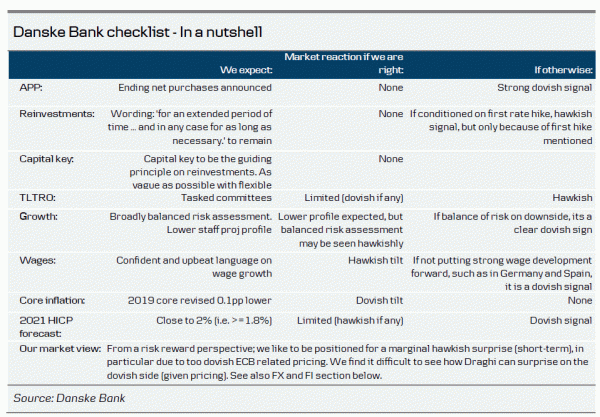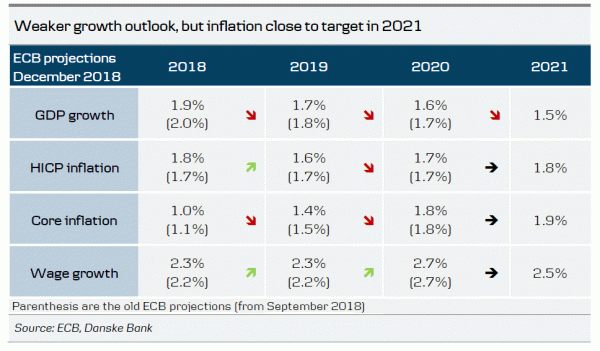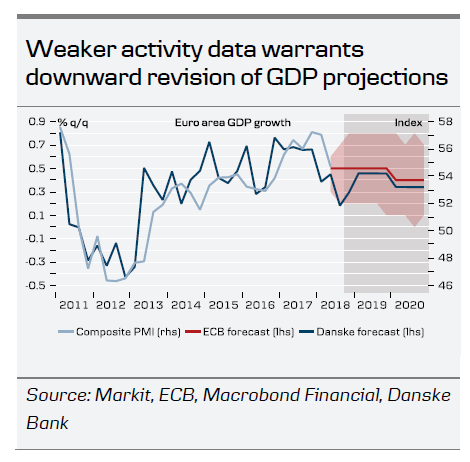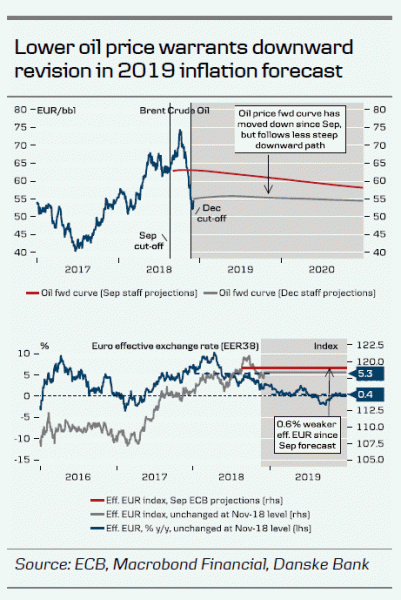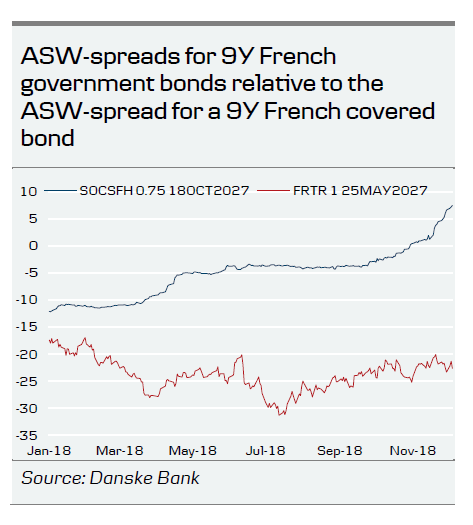- The new reinvestment strategy could be the most interesting part of next week’s ECB meeting, when a formal announcement about the end of the net asset purchases is set to be made.
- Although the stakes are high at the meeting, we expect Draghi to try to be as ‘dull’ as possible in order not to move the markets.
- Growth assessment as well as new forecasts (including 2021) will be closely monitored. We will pay close attention to the wage growth assessment.
- Given the current dovish market pricing we have a hard time seeing how the ECB can deliver a message that would lead to a dovish market reaction.
In conclusion:
We expect Draghi to repeat his ‘glass half full’ message, thereby acknowledging that economic developments are broadly on track. Therefore, despite a (on paper) hawkish policy move of ending the net asset purchases, we expect a dovish tightening as a confirmation and reassurance of an accommodative monetary policy stance going forward. We expect no new guidance on a first rate hike.
We also expect Draghi to voice concerns about the growth outlook but to still keep the broadly balanced risk assessment, which in our view is needed to end the asset purchase programme (APP). We expect a cautiously optimistic tone from Draghi on the (core) inflation, but a relative upbeat and confident wording on the wage growth developments.
Ending QE is given – look for the reinvestment strategy
The ECB Governing Council (GC) meeting on Thursday next week has been the most anticipated meeting since the June decision when the ECB implicitly already announced an end to QE. Therefore, fully aligned with market consensus, we expect a formal end to the QE programme next week. However, given ECB’s ‘patience and prudence’ view on monetary policy, we expect a ‘dovish tightening’ to fit with ECB’s narrative in the recent period. Therefore, we also expect ECB to confirm and reiterate its accommodative
monetary policy stance.
Consequently, the future of the QE programme (the reinvestment strategy) will take centre stage. We expect ECB to outline its future strategy albeit it being relatively vague, as we doubt that we will get much new colour on duration, and to repeat its intention to reinvest ‘for an extended period of time (…) and in any case for as long as necessary.’ The important job for Draghi, however, is to convince markets that no balance sheet reduction will take place before the first hike. A stronger version could be date dependent, such as ‘through summer 2020’ but we doubt it will commit to this already, as we have to get used to the new style of Aesopian forward guidance (as introduced by board member Benoit Coeuré
in September).
We do not expect ECB to announce an ‘operation twist’ to its holdings (favouring longerdated bonds to shorter-dated ones), which was mentioned by some media outlets
Capital key
This week ECB announced its new capital key structure as of 1 January 2019. While this is normally not something that catches the markets’ attention, it has received attention from market participants given that the capital key has been used to guide the PSPP. The update contained the revision of the German capital key by +0.82pp and Italy was revised down
by 0.53pp.
The verdict is still out whether ECB will adopt the new capital key or stick to the old capital key for the reinvestments. Last week, a Reuters story reported that two possibilities were considered: (1) taking a snapshot of the cumulative capital key deviations by the end of this year and ‘reset’ the deviation or (2) applying the new capital key to the existing stock and gradually fading the deviation over multiple years. We expect the latter, but importantly a flexible implementation is warranted as, in essence, the ECB wants to avoid a significant
market impact.
TLTRO – it will come, but ‘hold your horses’
As we discussed in ECB Research – TLTRO3: Italy to be main beneficiary, 9 November 2018, we expect the ECB to offer a new Targeted Longer Term Refinancing Operation. While the discussion has started in the market, ECB has not discussed it much. Previously, chief economist Praet said that the ECB is aware of the liquidity situation given the new
regulation as of summer next year.
The modalities for such a new round are highly uncertain, but we argue in the piece mentioned above that the extension of the maturity date is more important than any potential additional take up. We also find it premature to announce a new round at the December meeting next week but we expect the ECB to acknowledge a risk of tightening liquidity conditions next year and consequently to have asked ‘tasked committees’ to study this. TLTRO is a natural tool in response to that. We expect a formal announcement in Q1,
most likely March, and implementation in Q2, most likely June.
Since the last meeting
Since the latest GC meeting on 25 October, we have received a number of data, mainly on the downside. However, during the past few days, we have seen some stabilisation of the surprise index after moderate positive surprises.
Activity / confidence
After PMI misses early in the month, final PMI and euro area economic confidence data were less bad than expected, which is encouraging. Industrial confidence and business climate have edged up slightly as well, which could be seen as a first sign of a bottoming out of macro data in the coming months. The PMI service sector growth remained more resilient, with sales reportedly buoyed by strong labour markets in some countries, linked in turn to higher consumer spending.
The GDP figures for Q3 were disappointing across the board and early indications for Q4 GDP could suggest that the German car-related backlog will not disappear already in this quarter (see also Euro Area Macro Monitor, 5 December 2018).
Inflation
November HICP inflation fell back below 2% for the first time since May this year, as the boost from higher energy prices increasingly starts to wane. A slowdown in headline inflation was widely expected, but core inflation declining back to 1.0% (-0.1pp) in November was a clear disappointment, as higher wages yet have to show up in durably
higher services prices.
Early releases of country level data show an upside risk to the Q3 wage growth data for the euro area as a whole from 2.3% in Q2, to be released later today. For example, Germany
rose 3.2%, while Spain rose 1.7% in Q3.
Euro area negotiated wages released this month indicated a small easing to 2.15% in Q3 from 2.20% in Q2, but remains significantly above the growth rates observed in 2016 and
2017.
Higher wages to feed core inflation optimism
The December meeting will also be an interesting one in another respect: the new staff projections will include the 2021 forecasts for the first time. A downward revision in the 2018 core inflation and growth forecasts is a done deal, given that momentum on both fronts has disappointed since September. The boost from the higher oil price to headline inflation is waning and core inflation will likely end the year where it started at 1.0%. Q3 growth was less than half the rate the ECB expected back in September and so far forwardlooking indicators do not point to a rebound in Q4 activity.
With lower oil price assumptions feeding into the projections, we also see scope for a downward revision in the 2019 core inflation forecast. However, we expect Draghi to downplay recent core inflation misses and point instead to upside surprises on the wage front (Germany 3.2% y/y and Spain 1.7% y/y in Q3). Accelerating wage growth will keep the ECB’s inflation confidence alive and we therefore expect the ECB to release a 2021 core inflation forecast close to the 2% target, although it seems on the high side at the
current juncture.
Clouds are increasingly gathering on the euro area growth horizon and consequently we expect the ECB to revise down its GDP forecasts to 1.7% in 2019 and 1.6% in 2020 but importantly to maintain the ‘balanced’ growth risk assessment (a pre-requisite to end the QE programme). Markets will also keep a close eye on the 2021 forecasts. From tradition, we expect the ECB to forecast HICP inflation ‘close but below 2%’ at the end of the forecast horizon, as we argue that if that was not the case, the ECB should change its current monetary policy stance. Further, we expect the ECB to project growth returning to
potential.
FX: getting closer to the EUR rebound – but not there just yet
While we maintain that the ECB is priced too softly, the fact that we expect no new rate guidance at this meeting implies that FX markets should take their cue from the ECB’s stance on the cyclical position of the euro zone. Despite recent loss of growth momentum, if Draghi strikes an upbeat tone due to recent constructive wage developments, it could make room for some EUR support. We do stress, however, that any EUR/USD rally is likely to prove temporary as USD support remains in place in our view from a now rather dovishly priced Fed. We reiterate our long-held view that as we get closer to the first ECB hike, capital flows will become less EUR-negative as reserve managers are lured back to the euro zone. Indeed, both euro-zone portfolio investment flows and reserve-allocation data (see chart) suggest interest in EUR assets declined as QE and negative rates were introduced. This could reverse swiftly as the ECB ‘normalises’. We are long USD carry at present but positioned for a EUR/USD rebound beyond Q1 in our FX Top Trades 2019 – our guide on how to position for the coming year, 4 December 2018.
Bunds are expensive
The ECB December meeting has previously been bearish for rates. In 2016, 10Y German government bond yields rose some 20bp at the start of December. In 2017, 10Y German government yields rose some 50bp. Today we are back below the bottom in December 2017 and the ECB is about to end QE. Furthermore, market pricing is currently very dovish as there is very little priced into the curve. Currently, only 7bp is priced in by December 2019 and consequently, in our top trades published earlier this week, we recommend to pay Mar-20 and receive Sep-19 Euribors, see Danske Bank 2019 Fixed Income Top Trades, 4 December 2018
When we look at the European government bond markets, there has been very limited impact from the tapering seen during 2018, where the ECB has gone from EUR60bn to EUR30bn and down EUR15bn in the PSPP programme. The ASW-spread for the core markets has tightened in the long end of the curve, where we would have expected underperformance of core and semi-core EU government bonds. However, in the covered bond and credit markets we have seen an underperformance versus swaps as shown in the chart below, where we look at an example of a 9Y French government bond and a 9Y
French covered bonds relative to swaps.
Given that net supply is set to rise in 2019 as we do not have the QE, we expect to see some underperformance in core and semi-core EU government bonds and with market pricing being very dovish, we expect to see the same pattern on the outright level for yields as in 2016 and 2017. However, we do not expect that the sell-off will be as violent as in late 2017 and early 2018, when rates moved some 50bp. We expect that Bunds will be back up to 0.5% by the end of January




